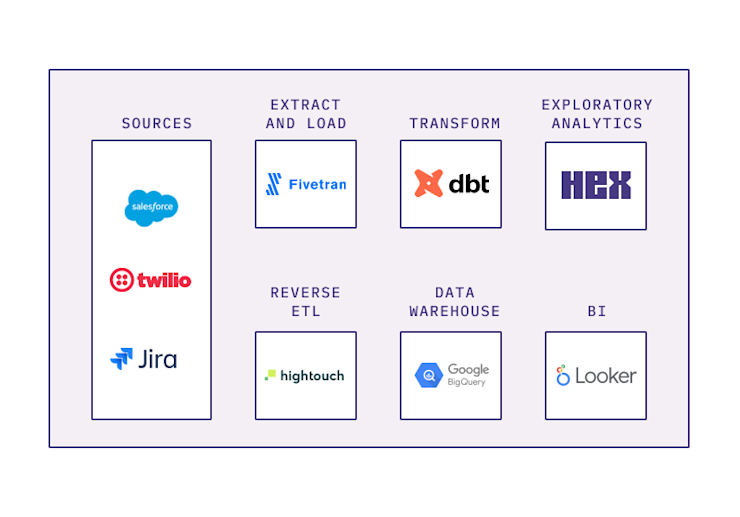Blog
Q&A with Bluecore’s Data Team: Part 1
We spoke about Bluecore's data team and modern data stack, use cases for Hex, and more

The interview has been condensed and edited for clarity.
Alex Sacco is Bluecore's Senior Director of DataOps & Analytics; before Bluecore, Alex held Analytics & BI and Strategy roles at AlphaSense, CB Insights, and Luminary Labs. Adam Whitaker is the Go-to-Market Analytics Lead for Bluecore, with previous Data & Analytics roles at Gopuff, Monetate, and Boeing.
Karina: Let's start with a quick introduction – who is Bluecore and how are you helping retailers modernize the way they do business?
Alex: Bluecore is focused on helping retailers find customers and keep them for life — and do all of that faster than any other martech platform. We're built specifically to quickly unlock and activate retail data through digital campaigns, which means we can have a laser-focus on challenges that are unique to retail. That makes us the best solution to drive revenue fast for the top retail brands in the world. Bluecore's predictive models are also trained on more data, so they're getting smarter and better based on the freshest, most up-to-date product info and shopper behavior, which makes our predictions more accurate.
We have a performance-driven model, which means we bet on ourselves and tie ourselves to a customer's success — which you don't see a lot of out there. For example, we price on clicks per email, not sends, so we're as close to revenue as possible. That way we're being more selective, sending fewer campaigns but better ones that are going to result in higher adoption. We want to incentivize our customers to be more effective and hold ourselves accountable for driving better outcomes for them.
You mentioned that when you first started, a lot of what you were doing was standing up the data stack at Bluecore. How did you go about doing that and what does your data stack look like today?
Adam: Our warehouse is BigQuery. We use dbt for all the transforms. We use Looker internally for BI. And we use Hex for development, exploratory analysis, prototyping and some light data eng/pipelines.
Speaking of pipelines, we use Hightouch to sync transformed data back into Salesforce and other SaaS tools. We ingest data via Fivetran from SaaS tools like Salesforce, Twilio, Jira, etc.

Alex: Bluecore has a very developed data science organization. DS is a core part of our product and it's a competitive advantage because we rely heavily on predicting shopper preferences and behavior. Data investments had been heavily oriented to improving the product. That's why Bluecore made fundamental performance leaps versus our competitors.
But by comparison, DataOps or our internal analytics was less mature. So that's where I started off with Bluecore in early 2021 -- getting the org alignment, vision, and prioritization to build this function, get the team and tooling in place.
The goal then was to create a central source not just for quality data, but for analytics tooling and process. We've introduced a deep analytics engineering discipline, more structured internal data support processes, and consistent data activation with tools like Hex and Hightouch as well as Looker.
Our goal is to continue adding depth and breadth, especially in data activation. That means more department-specific analysts and more focused BI development. This paves a path to velocity at scale and for more enablement - helping foster data & analytics firepower across the org as we grow.
Hex is a big part of that. It gives us a ton of flexibility. It gives us transparency, replicability, collaboration. The analytical work we do in Hex simply wouldn't have the same impact if it was hidden away in Jupyter notebooks.
Higher-level, we want to be adopting tools that have a lot of runway – low floor, high ceiling. We want to show to potential hires that we invest in giving great people the best tools, and get them excited about the stack we're using.
Going back into the alerting use case that you were describing, can you talk through the systems that are involved in making those alerts happen in a timely fashion?
Adam: The goal for this work was two-fold: first, to quickly surface client performance issues to Bluecore's internal support teams and second, enable fast diagnosis and resolution.
This hits on a lot of capabilities that make the modern data stack shine - reliable transforms and solid analytics combined with operational integrations to drive action.
The core modeling is done in dbt, with Hex for UI. We're also integrating a ticket creation process directly in Hex to close the loop between issue discovery and resolution.
For alerts, we look back at a period of time and ask, “What's the normal performance?” And then we look at the most recent data point - a single email campaign, for example - and say, “Is it within the bounds of what we expect it to be?” This happens in dbt using our data warehouse data, and stamps a TRUE/FALSE flag in the table. We then build a table only for alerts, keeping history and adding dimensionality for easy business use (account, rep, etc.).
In Hex, our users on the business side can see and explore all the alerts that impact their clients, and get all the data needed for deeper diagnosis by technical support teams.
But how do we make it timely and actionable? It needs to go into Slack. How do we ensure operational follow-through? It needs to go into Jira, there needs to be a ticket.
That's where Hex's flexibility pays off. We're using the Jira API to create tickets from within the Hex UI. That means that business reps can easily spin up new tickets without cumbersome copy-pasting, screen shots, etc.
It gets the key information into the established process for issue resolution at high speed, freeing the rep up to focus on helping clients.
In addition to internal use cases, we understand you're using Hex as a beta program to test new functionality with customers. Tell us more about that.
Alex: One of the key unlocks of Hex has been the ability to service very sophisticated clients with bespoke analytics solutions. Because of our strong data warehouse, we can spin up powerful custom work fairly quickly, sometimes within a sprint. And instead of a static spreadsheet, it's interactive, live, and dynamic.
Clients love this, and it gets the sales team excited because it shows we're going above and beyond for our customers.
Beyond short-term client wins, this motion creates a rich prototyping/learning environment with Hex. Custom work in Hex informs the next iteration of analytics features in the UI.
This way, you're testing your metric design, viz, etc. and getting direct client feedback without overhead from UI/UX and engineering. But migrating to the UI is easier because the data warehouse transforms are built and all the last-mile logic is clear in Hex. Engineering can hit the ground running.
Were you doing any of this before with your big clients? If so, how?
Alex: Different ways - spreadsheets, decks, Looker dashboards, data exports. Those were all reasonable channels at the time, given the tools on hand and velocity required. But now we're at a much higher level of maturity.
The team has evolved. Our ability to create so much value with Hex is a factor of us having a very deeply developed, strong analytics engineering capability and amazing analysts. We can have high velocity because we have both a solid foundation and skilled data practitioners. That's the meta story of why the modern data stack is so powerful.
Adam: I can't even tell you the last time we shared around a Google Sheet or Excel file or CSV or any of those things. It just doesn't exist anymore. And that's just locking in gains.
Previously, you'd see Slides and PowerPoints and Keynotes. Our team isn't even presenting data in those ways any longer. It's now just, “Here is the published app that you can go consume. And by the way, there's also interactivity in it. You want to change the time frame?” You've just given somebody the tools to go answer the questions that they have as soon as they see that dataset without the back and forth. So huge amounts of time is saved.
At Coalesce, you'll present a revenue forecasting app that you've built. Give us a teaser.
Alex: That is an awesome project. It distills what you can do with the right tooling and process.
Hex enabled a very powerful forecasting app that balances nuanced user inputs and accurate, reliable, yet flexible outputs.
We serve some of the largest retailers and brands in the world. So we standardize as much as possible, but clients expect the nuances of their business and strategy to be taken into account.
For example, seasonality differences or market mix strategy both meaningfully impact expected results. How do you encapsulate that nuance?
Hex gives us that flexibility, while keeping guardrails for consistent quality outputs. And - critically - that data has to be retained and activated. And through Hex's writeback functionality we can retain both the outputs and inputs, giving us full clarity into how the client's forecast was built. If a client is off track mid-contract, we can clearly point to why.
Operationally, that is a huge win because it frees everyone up from data detective work. It gives clients more confidence and visibility in our forecasts. And it gives us the ability to learn and improve our forecasts over time.
Learn more about Bluecore's forecasting app – tune into Adam's Coalesce session: Data automation with dollars on the line:Forecasting 7-figure deals with Hex, dbt and Hightouch.
And check out Part 2 of this interview with Alex Sacco and Adam Whitaker, where we'll dive deeper into how they build their revenue forecasting app, how the team prioritizes projects and measures success, reasons for adopting Hex, and more.
If this is is interesting, click below to get started, or to check out opportunities to join our team.